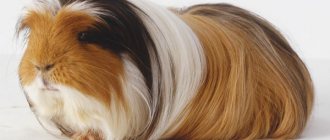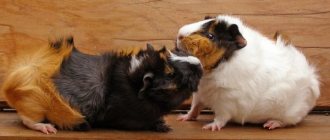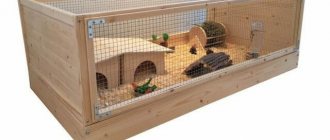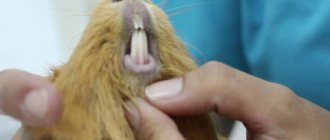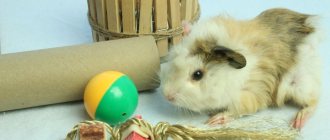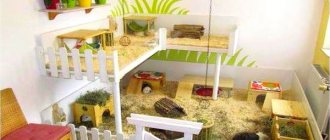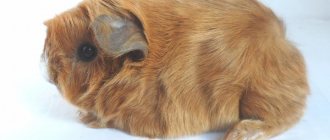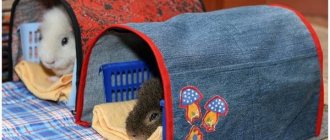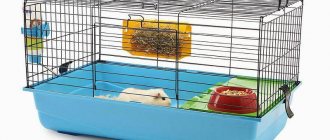Walking a guinea pig on a leash is not a Japanese exoticism, but a real picture that can be seen more and more often. A leash for a guinea pig is a simultaneous solution to 3 problems:
- The rodent grazes on fresh grass, allowing it to rummage in the ground and run around outside the cage. Fresh grass, sun and freedom are pleasures that will make your pet even happier.
- Eliminating the risk of escaping. Without a leash, a pig can scurry into the bushes and hide there. This happens when cats and dogs appear nearby.
- Reducing the risk of obesity. After the winter season of feeding cereals, pets gain weight. Walking around the yard or even around a large room will help burn off excess calories.
Types of leashes
Pet stores offer a wide selection:
Collar with leash.
This type of collar specifically for hamsters is used infrequently, only if the pet is a large breed. Usually it is worn as a decoration, since walking with such a collar is problematic, because the pet can slip out of it at any moment.
Harness for a hamster.
This type of collar is more reliable and is best suited for walking. A loop made of leather or fabric material secures the body and legs and is attached to the back. This design will definitely not allow the animal to wriggle out. The harness is put on loosely, so that you can stick your finger into the gap between the loop and the hamster’s body. The collar should not be worn tightly or loosely, otherwise the hamster can be injured or create conditions for escape.
Harness vest.
A vest harness is much safer and more reliable. It is believed that the hamster is more comfortable in it
Please note that the harness and collar must be securely fastened, otherwise the hamster may be lost somewhere
Walking ball.
Another worthy option for walking your pet. The walking ball is not a leash, but at the same time it is quite comfortable to use. The material of the device is usually plastic, the ball is dotted with special holes. This option is best suited for walking dzhungarikas or other small breeds, so the hamster will definitely not run away. Larger breeds of rodents will feel uncomfortable, so their use does not make sense.
How to properly put a leash on your pet
Putting on a harness made from straps is simple: you need to put a smaller ring on the rabbit’s neck. It will hold the animal in place with minimal girth. Pass the second belt under the lower abdomen and fasten the ring on it. Attach the leash carabiner to the strap on your back. If the harness is worn correctly and has a good design, on the side of the animal the joints of the straps form the correct letter “H”.
The harness-clothing is simply fastened first on the stomach, and then on the rabbit’s neck.
A self-made harness is put on differently: the front legs are threaded into the harness ring so that the ribbon dividing the ring runs along the tummy. The sides of the ring are connected at the back with a leash carabiner.
If you purchased or made your own rabbit harness and managed to put it on correctly, feel free to go for a walk with your pet! Do not forget that the time of year should be warm, the place for walking should be quiet and safe. Then you and your furry and eared family member will fully enjoy the walk.
How to make a harness with your own hands
If the pet store does not have accessories of this type or you could not find a suitable one, then you can easily make it yourself. No special pattern is needed. All you need to do is carefully examine the harness in the photograph and accurately measure your pet.
Taking all this into account, sewing a collar yourself will not be difficult.
A few tips you might find useful:
- Organize a strong and reliable fastening.
- The material should be thick or leather.
- The harness should be bright, for greater practicality.
- The size should not be large or small.
A homemade harness is different from a store-bought one; it is much more convenient, because it is tailored individually to your animal.
After the harness, all that remains is to pick up the leash. Any strong rope to which you need to attach a carabiner is suitable for this.
It is better to wear a collar at home. If the hamster does not give in, he needs to be distracted with tasty food. The pet will immediately forget about the leash when it finds itself on the grass. He will have more important things to do. If this does not happen and the animal tries to escape, most likely the harness is causing discomfort to the hamster. If you carefully choose and choose the right leash, walks can make your pet a little happier.
Tips for choosing a harness
Guinea pigs should not wear a collar! If you wrap it tightly, the animal will suffocate; if you wrap it weakly, it will slip out. They have weak neck muscles. Special harnesses are sold for walking with a leash:
- in the form of a vest: you can sew it yourself or buy it;
- in the form of stripes: it is universal due to size regulators: as the pig grows, it can be increased;
- figure eight harnesses.
When trying on a vest, check the gap: a finger should fit between the fabric and the body (not the fur!). A harness costs less, but the pig has more discomfort due to the position of the harness.
Leash length
This parameter determines how far the dog can move away from the owner. The longer the leash, the more comfortable the pet is on a walk. At the same time, control over the dog’s movement becomes more difficult, and the owner will be forced to carry the extra length of the leash in his hand (roulettes do not have this disadvantage). But a leash that is too short is also inconvenient for a four-legged dog. Therefore, the size of most products varies between 1-5 m.
The length of the leash depends on the breed and temperament of the animal, as well as the purpose of use:
- small rocks – 2-3 m;
- medium and large breeds – 3 m or more;
- active dogs – 4-5 m;
- walks without a leash - 1.5 m (equipment is needed only to bring the dog to a closed area);
- training – 1-2 m (working out basic commands), from 5 m (working out the commands “Apport”, “Place”, “Come to me”).
Approximate length of leashes based on type:
- classic – 1-10 m;
- tape measures – 2-8 m;
- re-stitches – 2 m;
- ringovki – 1.2-1.8 m;
- carriers – 0.4 m;
- chains – 1-1.5 m.
DIY hamster harness
If you are planning to take a furry friend to your dacha, read the information on how to make a leash for a hamster with your own hands. We warn you right away that when creating an accessory you need precision; approximate dimensions will not work. If the suit is too small for your pet, it will put pressure on its neck and tummy, and if it is too big, the homa will quickly wriggle out of the vest and run away.
So what materials do we need?
- paper, pencil, measuring tape, ruler, scissors - to create a pattern;
- a needle with strong thread, fabric and insulation;
- small metal rings (d=0.5 cm);
- a small carabiner made of metal or plastic;
- cord or strong tape.
A do-it-yourself harness for a hamster is made according to the individual size of the pet. To do this you need:
- Using a measuring tape, measure the circumference of your pet's neck closer to the chest.
- Measure the circumference along the tummy and back.
- Then you need to find out the distance along the ridge from the neck to the lumbar region.
All these measurements must be transferred to paper, a pattern must be made, adding 1 cm to the seam allowances and 2-3 cm to the straps around the neck and abdomen. Then the pattern should be transferred to the fabric (it should be strong and not stretchable). Use a pencil or chalk to draw the outline of the future product and cut it out. If you are sewing a summer vest, you can make 2 layers of fabric, but in the case of an insulated version, the pattern must be transferred to padding polyester, flannel, etc. By the way, there is no need to make allowances for the insulation!
Press the insulation between the two sides of the vest, fold the seams inward, and sew all the large pieces together. You should get a flat figure. Try it on your hamster to see where to close the vest under the neck and tummy. The metal rings will be located here.
Attach a carabiner with a leash to the back of the vest, which can be made from a linen cord or a strong bright ribbon. You can also weave it from beads, string beads and rhinestones.
By the way, remember that for babies the vest must be sewn with a margin so that the accessory does not become small when the animal grows up. To do this, add a few centimeters to the straps that are secured under the pet’s neck and tummy.
Thus, accessories for walking outdoors for hamsters are not necessary things; the homa will live well without them. But if you are going to take your animal out for a walk, you can buy your fluffy a leash or make a walking vest with your own hands.
In order for a hamster to be healthy, it is important to provide it not only with high-quality nutrition, but also with conditions for physical activity. Some owners purchase toys - wheels or mazes
But such things cannot replace quality walking. Therefore, you should buy or make a leash for your hamster.
- Why walk
- Accessories for walking
- Making a leash
- How to make a vest with a leash
- Conclusion
DIY hamster leash
Pet accessories
Modern manufacturers of accessories for keeping a pet are trying to release a variety of gadgets that no one had ever thought about before. They even produce diapers for guinea pigs. And this is just one example of accessories for keeping an animal.
Additional products for caring for a guinea pig may be:
- claw stone;
- branch for chewing;
- brush for caring for fur lint;
- tunnels made of plastic pipes (with a diameter larger than the cross-section of the animal’s body);
- toys (ropes, swings, ladders);
- diapers (store-bought or homemade from fabric);
- leashes (which are used for small breed cats).
Rules for feeding Syrian hamsters
The owner of a hamster must know what to feed his pet and how to do it correctly. To do this you need to have an idea about their lifestyle.
Diet
Hamsters are animals whose greatest activity occurs in the evening. Be sure to take this into account when creating a menu for your pet. It is better to divide the entire daily diet into two parts: it is recommended to give the smaller part in the morning, and the larger part in the evening.
As for drinking, the hamster should always have clean water at room temperature freely available. For this, it is better to purchase a special drinking bowl. It is not recommended to place a bowl of water in the cage - an active animal will quickly knock it over. In addition, debris will constantly fall into it.
Vitamins for golden hamster
Pet stores sell special vitamin complexes for rodents. As a rule, they are available in liquid and solid form. Vitamins in liquid form can be added to the drinking bowl, and in solid form - in food. The first option is more convenient, but also more expensive.
You can put a mineral stone in the rodent's cage. It helps the hamster grind down its incisors, improves digestion and supplies the body with essential minerals. Hamsters usually gnaw on such stones with pleasure.
There are also chalk stones on sale that supply the body with calcium and other trace elements. They can be either regular or with various additives - herbal or fruit. Such stones are especially useful for pregnant females. Under no circumstances should you give your hamster regular school chalk - it is not food grade and can therefore be dangerous for the small rodent.
How to avoid digestive problems?
The hamster's diet should be balanced. If you buy ready-made food and mixtures, be sure to check the expiration date.
Hamsters love to hoard food, and rotten food can cause digestive problems. Therefore, from time to time it is recommended to check the hidden places of the cage and throw away any spoiled food.
Typically, adult and healthy hamsters do not suffer from indigestion. If your pet still has problems, try giving him boiled broken rice for diarrhea or a little vegetable oil for constipation. And be sure to review your hamster’s menu so that digestion returns to normal.
It’s good if the food has a protein component
Dangerous things
If you decide to have such a pet, it is worth knowing what toys are available for your guinea pig and which are strictly contraindicated for it. When setting up a cage, do not install a wheel in it under any circumstances. A pig is not a hamster, it is much heavier, its spine is not so flexible, and therefore the wheel can cause injury to the animal, the same can be said about walking balls that people like so much. Besides, the ball will simply be useless. The pig will not be able to see through its walls, as it is nearsighted. She will just sit in a cramped space, staring at the walls.
A leash for walking should be ignored, as it is as dangerous for the animal as a wheel. If the pig gets scared, it will begin to break free from its leash and squirm, which can lead to broken ribs or spine. This defenseless creature will never show that something hurts, even if it hurts very badly, so the owner may find out about the fracture too late, when it will no longer be possible to help.
Don't waste your money and don't buy chalk sticks to grind down your teeth. To do this, bring a soft twig from the street, or even better, give the animal more hard vegetables and fruits. Pig teeth are worn down without the help of pet store products, by biting and chewing hard food.
Knitted clothes
If you are not comfortable with a needle and thread, but are great with knitting needles, then we hasten to please you - knitted clothes for dachshunds are easy to make and practical, just like those made from fabric. For this work, 200 g of any yarn of medium thickness will be useful: perhaps you have a ball lying around from a previously knitted scarf or sweater, or you purchased a warm woolen thread especially for this case. Here are some tips for creating a stylish sweater:
Start knitting it from the neck.
- On the back side, reduce the number of stitches to avoid the formation of folds and wrinkles.
- The sleeve knitting technique is similar to the technique for the fingers of gloves.
- Decorate the finished sweater with decor or add buttons.
The variety of yarn colors allows you to create not only clothes that are comfortable for your dachshund, but also a whole work of design art.
Advanced knitters can afford to give their pet a whole costume: a warm blanket or sweater and boots in case of particularly severe frosts. An evening of work will be fully repaid with doggy joy.
Types of leashes for hamsters
Pet stores offer a choice of three types of walking devices for hamsters. The ball is mistakenly included in this list: but what kind of a walk is it if the little animal has to work with its paws and not get to know every blade of grass.
Here are the main types of leashes:
- harness This is a reliable and safe device. The loop is made of leather or fabric. The design covers the body and legs, then is fixed on the back. The main advantage is that the escape of the animal is excluded;
- harness-vest. Comfortable and durable design. Used like a regular vest. Attached with a collar, then with a leash;
- model with a collar. Used for large breed hamsters as decoration. The design looks like a regular collar to which a leash is attached. It is not recommended to walk your little animal outdoors wearing such a product: the pet will slip away unnoticed.
The disadvantages of each model are manufacturing defects. Devices are torn, mechanisms are disconnected due to strong jerks of the pet. Some products deteriorate the first time they are used.
To make a competent choice of a leash, take into account the features of its use. For example, a vest will be a good option for walks in nature. It is preferable to wear a harness and collar with a leash during house parties. Additional recommendations will help you buy the right product:
- the main material should not be stretchy, otherwise the animal will slip out of the clothes. A good option would be leather or a substitute;
- The length of the leash is selected taking into account the person’s personal preferences. A model that is too long will not work: in case of danger, it is difficult to pick up your pet in a matter of seconds;
- Some collars are equipped with a button to adjust the diameter. But the cost of such products is too high;
- There are various sizes of harnesses available in pet stores. Before purchasing, it is better to measure your pet’s body;
- Devices equipped with a metal carabiner will be durable. It is not recommended to buy plastic structures: they break quickly and cause the animal to escape.
Many owners of furry fidgets are interested in which harnesses and leashes have proven themselves to be successful. Here are a few popular models that definitely won’t disappoint:
- "Gamma". It looks like a simple harness made of cord. The length of the leash is 1.3 m, and the diameter is 6 mm. Suitable for walking large pets. Equipped with a metal carabiner and sliders;
- Ferplast. This is an open harness made from nylon cord. The size of the product is adjustable. Suitable for walking dwarf hamsters;
- "Ferplast jogging small." Made in the form of a vest. Suitable for wearing by large or well-fed hamsters. Has an adjustment mechanism;
- "Taonmeisu." This is a budget option for an open harness. Complete with a bell. The harness is made of nylon, and the fastenings are made of metal.
Not every person wants to shell out a certain amount of money for a strong rope with a collar. If you want to dress up and take your pet for a walk, you will have to try and make such a thing with your own hands.
Among the various products in pet stores you can see small harnesses for hamsters.
The trend towards providing motor activity to this rodent arose not very long ago.
And this is due to the fact that in the wild, a hamster can run up to 10 km per night in search of its main food - cereals.
- Do you need a leash?
- What are there
- How to make a leash for a hamster with your own hands Tools and materials
- Step-by-step instruction
What to look for when purchasing
A proper harness should fasten around your pet's neck and not be pulled tight. In this case, if a cowardly furry animal, frightened by the noise, starts to break free, it will not be able to accidentally strangle itself.
Put a harness on the rabbit and look at the pet from the side. If the jumper of the leash forms the letter “H”, then the harness is chosen correctly.
A typical harness for walking a pet consists of two open rings. To put on the walking device, you need to take the rabbit in your arms, put a small ring on the pet's neck and fasten it.
The leash carabiner is fastened to the back, the harness should not dangle, but it should not be fastened too tightly: a finger should fit between the harness and the pet’s neck.
When choosing a walking harness for your pet, you should pay attention to the following aspects:
- sizes. The harness should fit the rabbit well and not be too tight or loose;
- reliability. The fastenings of the structure and the material itself should not be damaged under loads and withstand the active movements of pets;
- clasp. It should be fastened and unfastened comfortably and securely;
- material. Must be harmless to the animal and wear-resistant;
- leash. Should be securely attached to the middle of the back. This arrangement is most convenient and safe for a nimble animal. The most acceptable option for rabbits is a roulette leash.
Choosing and arranging a home
To keep your pet, it is advisable to purchase a plastic or metal cage - it is easier to wash and disinfect. The cage size is at least 0.5 square meters. m for 1 individual. The bottom of the cage should be solid so as not to damage the paws when moving. Sawdust is placed on the floor in a layer of 1–1.5 cm, which is changed regularly. A drinking bowl and feeder, as well as items for games and recreation, are installed inside.
Cage or aquarium
An aquarium is an almost enclosed space. Air enters it only from above, which increases the temperature inside and worsens gas exchange. The disadvantage of an aquarium is that the pig constantly lives at elevated air temperatures, inhaling vapors from urine and feces. This is bad for your pet's health. Among the advantages of such maintenance is that the aquarium does not absorb odors after cleaning and satisfies the skinny's need for warmth - it requires 4 ° C higher than for representatives of woolen breeds.
When keeping a cage, you need to take into account that the cage should be spacious, non-traumatic and easy to maintain. Height is not an important parameter, since an almost 2-kilogram pig is unlikely to climb anywhere. The length is much more important - it should not be less than 100 cm, since the pet needs room to run.
We recommend that you learn how to choose and arrange a cage for a guinea pig.
Accessories
You can find very attractive cage options on sale, or purchase a long cage and customize it to suit your pet’s characteristics. The cage must have:
- house;
- drinking bowl;
- feeder
The floor is sprinkled with sawdust. The pet’s natural needs are managed in a bedding made of sawdust, which needs to be changed as it gets dirty. In large cages, a pig may choose a corner or several for the toilet. Regularly replacing sawdust in these corners will eliminate the smell without wasting bedding material.
In the side part of the cage you need to build a “house” - a fenced area with a roof:
- height – at least 8 cm (animal height – about 7 cm);
- width – along the width of the cell;
- length – about 16–20 cm.
The house must have an entrance. A drinking bowl is installed on top of the structure so that the animal does not pollute the water with sawdust. The feeder is placed in the side niches of the cage or on a hill in the corner. There is no need to keep the sand bath in the cage for grooming. It is better to place it in the cage 1-2 times a week for the whole day. This will reduce your costs for sand and cleaning the cage.
Did you know? The guinea pig sleeps with his eyes open. To sleep, 8–10 minutes are enough for her, after which the next 3–4 hour stage of wakefulness begins.
Singles or need a couple
Pigs are kept both together and individually. Among the opinions on forums you can easily find arguments both for and against keeping several pigs. Opponents of shared content argue their point of view by saying:
- a pair of a boy and a girl means frequent births for the female and the need to place the offspring somewhere;
- a pair of two boys may fight frequently;
- livability depends on the individual characters of each individual.
Proponents of cohabitation often say that a pet is bored alone and needs to communicate with its own kind. There is no scientific evidence for this fact, but it is worth considering that in the wild, pigs live in flocks of 5–10 individuals, dig holes together and, naturally, intersect in the same territory.
Therefore, the answer to the question of whether to have two pigs or one depends on your personal preferences.
Why does a cat need a collar, leash or harness?
Even the most phlegmatic domestic cats are happy with the new experiences that a walk gives. And if your pet has an active temperament or has lived on the street in the past, he may feel sad, sitting in the apartment all day long. In order to make walking with your cat safe and comfortable, special devices come to the rescue: a collar, a leash and a harness.
Walks give cats many new experiences
Collar
Some owners purchase anti-parasitic collars for their cats, which the pets even wear around the house. But for a walk you need a more reliable collar with a strong clasp.
If your cat walks, as the saying goes, on its own, you need to choose a comfortable collar for it that will not allow the animal to get caught on protruding dangerous objects and will not fly off during active movements. In addition, the collar must have a mount for an address book on which you can write the cat’s name, your phone number or address. If the pet gets lost or gets into trouble, the people who find it will be able to return the poor thing home. When deciding to walk an animal on its own, you need to be aware that it is unsafe.
The pet's collar must have a tag with the owner's number on it.
An option in which you can not worry about your pet, but at the same time give him the joy of a walk, is to use a collar in tandem with a leash.
Leash
As mentioned above, a leash is the key to a safe walk with a cat. It is best to opt for a long but strong leash. A chain, unlike dogs, is not suitable for cats - it is heavy and can scare your furry or cause him pain.
The cat's leash should be soft and light
And, of course, even when walking on a leash, put a tag with contacts on your cat’s collar - just in case.
Additional accessories for guinea pigs
Some products for guinea pigs will help make your pets' lives brighter and more comfortable. These are various toys, beds, hammocks and other convenient devices.
Toys
Pigs love to entertain themselves with toys - in pet stores you can find various balls and spools that quietly ring or rustle when rolled. It is better if the toy is made of natural materials, then the pet can chew it without danger to itself.
Guinea pigs love tunnel toys
Guinea pig tunnel
To satisfy your pet's need for movement, you can install fabric or plastic tunnels in an enclosure or in a place for walking. If you connect several parts together, you will get a labyrinth through which the pig will travel with great pleasure.
There are many types of tunnels sold in pet stores; you can also make such a toy yourself:
- Several rings are made from metal wire; the diameter should be such that the pig cannot get stuck.
- Each ring is sheathed; fleece or other dense fabric is good for work.
- The rings are connected to each other using pieces of fabric, at a distance of 10-15 cm.
- Hooks are sewn to the edges to secure or hang the device from the bars of the cage.
Parts and pieces of pipes for plumbing can be used as tunnels. They are usually made of durable plastic that your pig will not be able to chew through. You can get an interesting design if you cover the pieces of pipes with thick fabric in a nice color.
You can also make a labyrinth with your own hands from cardboard boxes and thick paper. Cut holes in the walls of the boxes, connect them with paper tunnels, install barriers and shelters - the pig will explore the new toy with great interest.
You can make tunnels for guinea pigs yourself
Guinea pig bed
Pets most often prefer to sleep in a house, but do not ignore soft beds and mattresses. These products can be selected at a pet store or sewn with your own hands.
A sleeping bag for guinea pigs is especially popular:
- Squares are cut out of fabric, the sizes depend on the size of the pet - about 10 cm is added to the length of the pig's body.
- The inner bag is sewn - the lining is made of soft fabric.
- The finished inside of the bag is wrapped in thin padding polyester, leaving 10 cm on the side of the opening.
- The outer bag is sewn from more durable fabric; the inner bag is placed in it along with padding polyester.
- The remaining 10 cm of the inside is turned outward and hemmed.
In such a sleeping bag, pigs feel protected, as if in a shelter, so it is sometimes used instead of a house.
You can choose bright colors for the product, but it is better to choose fabrics that can withstand frequent washing.
Guinea pigs can use a cozy bed instead of a house
Hammock
Pigs love to relax in a soft hammock, which is convenient to hang in a cage or enclosure. You need to hang the hammock at a low height, no more than 10-15 cm from the floor surface, otherwise the pet may fall and hurt itself.
The hammock should be hung low
Clothes for guinea pigs
Unlike dogs, clothes are not made for pigs for walking - suits, dresses and other things serve only for decoration and creating an image. Various costumes can be bought or made to order, or you can also try making clothes for guinea pigs with your own hands. The simplest outfit can be made from a regular sock in bright colors:
- The upper part is cut off to the heel, holes for the paws are cut out.
- The edges are rolled up and neatly hemmed.
- The fabric is decorated to the owner’s taste - beads, buttons, ribbons are suitable.
To make more complex, original outfits, you will need projects and patterns. You can find them on the Internet or come up with them yourself.
Photos of guinea pigs in clothes are very popular, but this is entertainment for the owners, not the animals
Leash and harness
To walk a rodent, a harness is sometimes used - it is best to choose a model in the form of a T-shirt that tightly covers the animal's body. The most convenient leash is a tape measure with a lock, but a regular leather or fabric cord will do.
In the photo, the guinea pig harness looks like clothing, this is the most convenient option
Diapers
When free-ranging at home, owners often want to protect the surfaces in the apartment from puddles. For this purpose, you can purchase or sew cloth diapers that are secured to the animal’s body using Velcro fasteners. But the effectiveness of this method is questionable - the pig will try to get rid of the diaper, and it will have to be changed too often. It is best to use a fenced space for walking your pet, which can be covered with a diaper for puppies.
Pampers for walking are not the best solution, they interfere with the animal too much
Benefits of walking
Veterinarians are divided on the issue of walking so many small animals. Some people think this is a bad idea, citing the high likelihood of the pig suffering psychological and psychological damage. Others counter with the factor of the benefits of fresh air for domestic rodents. Recently, popularity has shifted to supporters of active walks with guinea pigs - but with reservations.
Walking your pet in the average yard may not be a good idea. There is so much noise and traffic around that the pig can get psychological trauma. There is an even greater danger from other animals - street cats and dogs, who see such easy prey. They can do something irreparable. Therefore, you can only walk in quiet and peaceful places where danger is minimized.
At the same time, walks in the fresh air, the opportunity to run on the grass and chew on twigs to the fullest are very useful for guinea pigs. They may be domestic animals, but they are active and inquisitive animals. Their mood noticeably improves, which gives the owner positive emotions.
The benefits of walking a guinea pig include the following:
- These furry creatures are prone to obesity, despite their miniature size. Walking does not threaten them with this disease.
- Pigs are social animals; being confined to their own home can, oddly enough, depress them. Introducing such variety will help avoid stress in your mumps and its unpleasant consequences.
- A harness for a guinea pig is necessary - a guarantee that the animal will not disappear without a trace under the nearest bush.
If there are children in the family, a walk with your favorite pet will be a real adventure for them. Of course, you need to explain to them the rules of such a promenade in order to avoid incidents.
How to make a harness with your own hands
If the pet store does not have accessories of this type or you could not find a suitable one, then you can easily make it yourself. No special pattern is needed. All you need to do is carefully examine the harness in the photograph and accurately measure your pet.
Taking all this into account, sewing a collar yourself will not be difficult.
A few tips you might find useful:
A homemade harness is different from a store-bought one; it is much more convenient, because it is tailored individually to your animal.
After the harness, all that remains is to pick up the leash. Any strong rope to which you need to attach a carabiner is suitable for this.
It is better to wear a collar at home. If the hamster does not give in, he needs to be distracted with tasty food. The pet will immediately forget about the leash when it finds itself on the grass. He will have more important things to do. If this does not happen and the animal tries to escape, most likely the harness is causing discomfort to the hamster. If you carefully choose and choose the right leash, walks can make your pet a little happier.
What available materials can it be made from?
When choosing material for making a dog bed, listen to the recommendations of experts.
- It should be a fabric that is comfortable for the dog. Especially careful selection of material is required for short-haired breeds. The pile should not cause irritation, the canvas should not be squeaky. Consider options that are resistant to abrasion, claws, and cleaning.
- For smooth-haired breeds, it is recommended to choose materials that accumulate and retain heat. These include flock, velor, plush, felt, corduroy. For dogs who prefer to sleep warm, you can make a bed made of faux fur, but this material should be avoided if the bed is being made for pets with allergies.
- For long-haired dogs, beds made of smooth but dense material, for example, linen, jeans, or tapestry, are suitable.
- Comfortable, warm and soft padding can be made from foam rubber, padding polyester, batting, or holofiber. Do not use fluff or straw, as they may harbor bacteria and insects.
- Try not to use synthetic fabrics; they accumulate static electricity and can frighten your pet. In addition, this material can cause allergies in the animal.
In addition to the above materials, when making a homemade bed, you will also need other tools: threads, scissors, pattern paper. All this is available in every home, and paper can be replaced with ordinary newspaper. Before drawing up a project and choosing material, it is worth studying the types of dog beds.
Pillow. Suitable for both large and small dogs. It is done quickly, simply stuffed with foam rubber or synthetic padding. Doesn't take up much space, you can just put it in the dog basket.
Lounger with side. It is a crib with “walls”. Sometimes it can be made from the above pillow, inserted into a base with sides. Plywood or corrugated cardboard is used as the base.
Little house. Usually created for small breed dogs. Requires a lot of time to manufacture. Sewing can be done by taking, for example, a box as a base. For warmth, you can line the inside with sheepskin or faux fur.
Wooden bed. This option is made for large breed guard dogs. A wooden bed is often installed on the street next to the booth or directly in the enclosure. A more complex variety. For manufacturing you will need wood, screws, a screwdriver and other tools.
How to sew an accessory yourself
Let's turn to how to make a dog harness with your own hands. After all, anyone can sew a harness. Professionals can go further and pamper their pet with an unusual accessory that they knitted with their own hands.
- Taking measurements of your pet.
Regardless of the chosen method of making your own harness, you have to start by taking measurements. Only correctly taken measurements will help you sew an accessory that is ideal for your pet.
The chest circumference is taken behind the dog's front legs at the widest point. To the resulting value you need to add 2 centimeters for a loose fit.
The girth of the neck is determined in the place where the animal usually wears a collar.
The length of the pet's back is measured from the withers to the base of the tail.
- Choice of material for the product.
The next step is choosing the material. Strength, wear resistance, softness and ease of cleaning - these are the requirements for harness fabric.
Cotton and linen are considered the most suitable - they breathe well, nylon is easy to clean and does not get wet, felt retains heat.
Don’t forget about rings, clasps, carabiners and Velcro, which will help the owner to easily remove and put on the harness on the pet.
- Constructing a pattern and sewing a product.
Having completed all the preparatory work, we proceed to constructing a pattern for the product. Don't forget about 2cm seam allowances on all sides. The resulting pattern will form the basis for cutting the product onto the fabric.
For the convenience of wearing the harness, we cut out 2 pieces of soft lining (1 piece is acceptable) separately from the base.
Of course, you can sew parts together with a needle and thread, but a product stitched on a sewing machine will look more neat.
Fold the lining in half and sew it along the entire perimeter. We sew the lining to the harness.
Our creation is almost ready. All that remains is to stitch the rings in the back area for ease of fastening the leash. It is recommended to sew parts using a zigzag stitch. It is this that allows you to firmly sew rings and fasteners, which take on the main load.
The straps can also be equipped with fasteners or Velcro to adjust their length if the pet is prone to obesity or is still growing. It’s good when the harness fits exactly to the dog’s body
But you should pay attention to ensure that it does not cause discomfort to the dog, does not tighten his chest, or digs into his body.
It can also be bad and uncomfortable for the animal when the belts of the product sag. This can also injure your pet or provoke a situation where he breaks free and is in danger, or when the straps dangle under his paws.
To make sure that the sewn product meets the safety requirements for wearing, you can use the following verification method: you just need to stick your palm between the harness and the dog’s body. If it passes freely, the product was successful. Don't despair when something doesn't go as planned. After all, everything can start over. No wonder popular wisdom says: “The first pancake is lumpy.” If the creative passion has left the needleworker, then the workshop will help make his dream come true.
A separate recommendation for those who chose leather as the material. As you know, this material has excellent stretchability. Then, if an error was made in the calculations and the product is too tight for your pet, then you can save the fruit of your labors and try to stretch the product. This can be done in several steps:
- place the product in water for 20-30 minutes;
- then remove from the water and, without getting wet, tightly wrap it around some cylindrical surface (but not the battery), for these purposes you can use a bucket or canister; if the surface is narrow, like a pipe, then the product will eventually be “curly” and will create inconvenience for the pet;
- When the leather is dry, it will need to be thoroughly lubricated with shoe polish or other thick industrial fat.
The only disadvantage of this method of saving the product is the likelihood that the belt will turn out to be too thin and may end up cutting too much into the skin of your furry friend.
How and where to walk rabbits in a harness
The video shows how to put on a harness for a rabbit, and in what conditions it is better to walk it.
- If you decide to walk your pet, then initially he needs to be vaccinated to protect him from common dangerous diseases. For a walk, you should choose a quiet place where the animal will not be disturbed by noise and passing traffic, barking dogs, etc. A great place for a walk would be the territory of your dacha, if you have one. In this case, it’s even worth purchasing or making an enclosure for walking.
- The rabbit should be carried in a carrier to the place of walking. You should walk in warm weather - cold, wind and slush can negatively affect his health. In the summer heat, walks should be taken in the morning or evening, when the direct rays of the sun cannot harm the animal and it is not so hot outside.
- During exercise, you should monitor your pet so that it does not get tangled in the leash and harm itself. Make sure that the greenery growing in the walking area does not contain poisonous herbs. The following herbs can cause poisoning in a rabbit: cockle, hemlock, celandine, foxglove, buttercup, spurge, wekh, dope and others.
Important! Predatory animals can scare rabbits to death - these little ears do not tolerate stress well. Therefore, if you see a large dog barking loudly in a walking area, you should look for another place
It is recommended to carry the baby rabbit to the place of walking in a special carrier designed for pets. This reduces the likelihood that the animal will get tired or get hurt. The little rabbit does not obey commands like a dog and walks in the direction it chooses independently
You should behave carefully with it, since many things can frighten the animal, as a result of which it can begin to break free and run away
The preferred place for walking is the lawn
Since in nature rabbits are in constant motion, it is recommended to use a roulette leash, which will limit the animal’s walking radius at any time without scaring it. If the animal does not move, sits with its ears down and pressed to the ground, it is frightened by something. At such moments, the owner should pick up the rabbit and talk to it in a gentle voice to relieve stress and calm the animal.
It is not recommended to walk with pets outdoors in low air temperatures and winds, as there is a risk of catching a cold. The optimal time for walking is considered to be morning or evening in the warm season, so that the animal does not get sunstroke. If the summer evening is a little cool, the rabbit should dress up.
